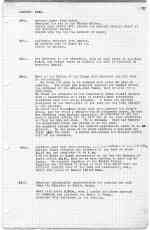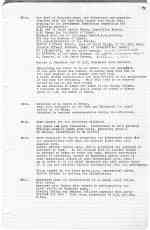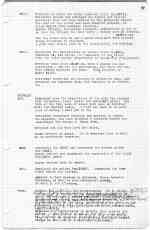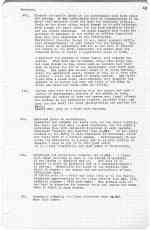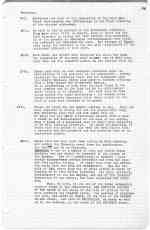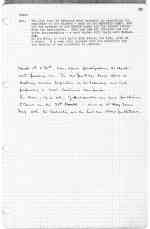Excavation journals and diaries made by Howard Carter and Arthur Mace
Howard Carter's excavation diaries (transcripts and scans)
3rd Season, January 19th to March 31st 1925
This is Howard Carter's journal for the 3rd excavation season of the tomb of Tutankhamun which took place at the beginning of 1925. The events covered by this journal are the Egyptian Government reinstating the concession for the tomb to Carter (January 25th 1925) and preparatory work on the outermost coffin (February 4th 1925).
The journal is housed within its original black ring-binder, stamped "Walker's Loose-Leaf Book, Cover Number 138" on the inside front cover, it measures 33 by 21.5 by 1 cm. and contains 148 loose-leaf, graph-lined pages. TAA Archive i.2.1, pages 137 to 147. Entries for January 19th to March 1st are typewritten, the final entry 'March 1st to 31st ...' is in Howard Carter's hand.
This transcript follows the format of the original document, and any insertions, deletions or duplications are indicated accordingly. Scans of the original journal pages are provided and are positioned to the right of the transcript, these are magnified by positioning the pointer on the image.
Arrived Luxor from Cairo.
Remained the day at the Winter Palace.
Called upon Tewfik Eff. Boulos the present Insp. in Chief of
the Antiquity Depart.
Called upon the Bey the Marmour of Luxor.
Callender returned from Erment.
We crossed over to Gurna 11am.
Called on Lythgoe.
Saw Merzbach in the afternoon, when we sent wires to the Min.
P.W.D. and Bedawi Pasha re opening the Tomb if possible on
Saturday (24th).
Went to the Valley of the Kings with Merzbach and his wife
in the morning.
We found the Tomb to be covered with about 50 c/ms of
rubbish. The kiosk and material removed and placed before
the entrance of the Akh.en.Aten Cache, that we used for a
dark-room.
We found the entrance of the laboratory (tomb No. 15) covered
with a construction of a kind of lattice-work completely
plastered over with white plaster. I trust the painted
sculpture of the door-jambs of the tomb has not been damaged
by the plaster.
We found that beautiful linen pall that covered the King's
grave, and for which I brought out Dr Alexander Scott, Mr and
Mrs Newberry from England especially to preserve it and had
made a special lining for it, left out in the open unprotect-
ed from the sun and wind. It is ruined! They had removed
the carpenters' kiosk and placed it on the pall.
The magazine (No. 4) from all outward appearances seems to be
alright. In the place of my locks (broken) a pad-lock was
fixed upon the door. A wooden sun-screen was erected before
half of the entrance.
Merzbach came over this morning., and we with Callender went to the Valley.
Baraize began clearing the entrance of the Tomb at about
11.15am. And completed it at 4pm.
H.E. the Mudir of Keneh accompanied by the Bey the Marmour of
Luxor called 12.45, just as we were leaving to meet him at
Luxor. We lunched together at the Winter Palace.
Merzbach was informed by phone or wire from Cairo that the
official handing over of the Tomb and laboratory, etc.,
would take place on Sunday (25th) 10am.
Received telegraphic authorisation for opening the tomb
from the Minister of Public Works.
Went into Luxor 3.30pm. When I handed the above message
to Merzbach and informed the Mudir of Keneh.
Returned with Callender in the evening.
The Tomb of Tut.ankh.Amen, the laboratory and magazine
together with the keys were handed over to me this
morning by the Government Commission comprising the
following people: -
M.E. Abd el Hamid Bedawi Pasha, Conseiller Royale.
H.E. Osman Bey the Mudir of Keneh.
Mohamed Riad Bey of the Legal Depart. P.W. Ministry.
The Bey the Marmour of Luxor.
Two representatives of the Police.
Tewfik Effendi Boulos, Insp. In Chief Up. Eg. Of the Ant. Dept.
Ibrehim Effendi Habbeeb, Insp. Of Antiquities, Luxor.
Mr. J.E. Quibell, of the Cairo Museum. Conseiller Services des Antiquités.
M. Lefebvre, of the Cairo Museum. (G. Lefebvre, Conservateur-Adjoint)
M. Baraize, of the Cairo Museum. Dir. De travaux. S des A.
Maitre G. Merzbach and Mr. A.R. Callender were present.
Everything was found to be in order, with the exception
of the pall which was ruined, it having been left out in
the open exposed to the summer heat and wind.
A heavy wooden construction had been erected in the antechamber
of the tomb for visitors. This will have to be removed
before we can do any work there.
We all returned to Luxor for lunch at the Winter Palace.
I remained in Luxor that night having to attend a dinner
given by H.E. the Mudir of Keneh.
Returned to my house in Gurna.
Went with Callender to the Tomb and inspected the great
coffin of the King.
Attended to various correspondence during the afternoon.
TOMB opened for the following visitors:
Sir Hamar and Lady Greenwood. (introduced by Lord Allenby)
Princess Mounira Hamdi and suite. (Ministry permit)
Dr Munthe. (Introduced by Mr Carter).
Work commenced today in preparing the laboratory ready for
the preservation work upon the objects there from last
season's work.
Tewfik Effendi Boulos came, and we discussed the question of
visitors to tomb. It was decided that no visitor should
be allowed to enter or visit the tomb, whether Government
invite or otherwise, except on Tuesdays, unless there be
some exceptional reason or some exceptional case, when I
am to refer it to the Chief Inspector who will refuse entry
if he has not received special instructions from the Government.
With regard to the latter point, i.e., exceptional cases,
Tewfik Effendi is writing for instructions.
Commenced upon the preservation of an ebony stick inlaid
with ivory.
Arranged with Burton with regard to photographing the
royal coffin on Thursday next.
General Haking and Admiral Jellicoe together with party
visited the tomb - they being introduced by H.E. the Min.
P.W.D.
Repaired an ivory and ebony veneered stick (no. 227a).
Callender sorted and arranged the timber and various
materials that had been removed by the Antiquity Depart.
The mass of the timber has been rendered useless, it
being warped from careless stacking.
Shaban Effendi, the Museum delegate, endeavoured to get me
to show his friends the tomb today - though they
For the first time we had a quiet morning's work without
being disturbed by visitors.
A good many tools, left in the antechamber, are missing.
Completed the preservation of curved stick No. 227a,
recorded it, and sorted the remainder of the sticks
from the outer shrine preparatory to their being photographed.
Merzbach came about 10.30am. When I signed the new
concession - one for the Government, the other for us.
Showed Madame Merzbach the Tomb. They returned to
Luxor 12.15.
Callender completed the sorting of materials etc., and
prepared the magazine No. 4. for lunching in as former-
ly.
Commenced upon the reparations of the gold fan inlayed
with turquiose, lapis lazuli and carnelian glass. The
palm of the fan, made of sheet gold upon an inferior wood, had buckled badly. I fear too much so to ever
hope of making a neat job of it.
Callender continued clearing and putting to rights
the magazine, and also prepared a platform beside the
sarcophagus for Burton to photo from.
Merzbach and his wife left for Cairo.
Lacau arrived at Luxor. It is reported that he will
go on southwards tomorrow.
Completed fan (245) and commenced the second golden
fan (242).
Lucas arrived and commenced the reparation of the black
resinnous goose.
Lacau visited Deir el Bahari.
Completed the golden fan (242). Commenced the bows
found beside the shrines.
Admitted to Tomb Baronne de Szilassy, Comte André de
Contades, as well as some Government guests.
No work in the afternoon.
Cleaned the upper surface of the coffin in the sarcophagus with warm water and ammonia. It is aston-
ishing what an accumalation there was - a kind of de-
posit for from moisture there was upon its surfaces - within that Even though the great sarcophagus, even wasthough it was closed very well when we found it. and the cracks cemented.
The workmanship on the face, particularly the cobra on the
forehead, is very fine, the inlay now it is cleaned tells
magnificently.
Examined the linen sheets or shrouds that covered the
coffin. They proved to two be two only - one small
one, bearing an eligible inscription, the other large,
folded in two, and of a much more open mesh.
Cleaned the coffin lying in the sarcophagus with warm water
and ammonia. It was astonishing what an accummulation of de-
posit from moisture there was upon its surfaces, particu-
larly on the glass inlay, which seemed to be most affected,
even though the great stone lid had been carefully closed
and the cracks cemented. It would suggest that there was
moisture or dampness in the coffin or coffins themselves
when they were deposited in the sarcophagus.
Provisional cleaning though it was, under somewhat diffi-
cult circumstances, it well repaid for the trouble. The
inlay shows up splendidly and one is now able to realize
the beauty of the work, especially the uraeus upon the
forehead which is really a magnificent piece of work.
I examined the shrouds or linen sheets that covered the
coffin. They were two in number, one, a very large one,
had been folded in two, which made us believe last year
when we raised the lid of the sarcophagus that there were
three. The upper and smaller sheet is of close weaving,
while the underneath sheet, folded in two, is of very open
material - after the nature of coarse muslin. The first
sheet bore a linen mark, unfortunately very illegible but
appears to be merely the name and title of the King in
black ink which has eaten away the fabric.
Burton came over this morning with his camera and took a
series of photographic records of the coffin in situ.
Completed the series of bows and arrows etc. found between
the shrines in the sepulchral-chamber. Recorded them, and
they are now ready for final photographing and packing for
Cairo.
Tewfik Eff. Paid me a visit this morning.
Replaced glass on sarcophagus.
Preserved and indexed the seals from the two inner shrines.
The seals and cord were in good condition, but for safety I
saturated them with celluloid dissolved in amyl acetate.
Commenced treating the cosmetic vase no. 211. It was badly
stained by the fatty or oily substance it contained, which
was still soft to a certain degree. Unfortunately it has
eaten the aragonite in places, but by careful soaking in
benzine I hope to get it in fair good order.
It is a very interesting and good piece of workmanship.
Completed the aragonite cosmetic jar no. 211. I found
that after removing as much of the stains as possible
it was better to paraffin wax it. Now that it is
cleaned it shows up admirably and is an exquisite example
of design. Especially the heads of the captives upon
which it stands - two negroes and two northerners of Med-
iterranean type.
Dr Munthe paid us a visit and lunched with us in the Valley.
Commenced experimenting on the large calcite vase 210, with
caryatid figures - Nile gods HAPI. The problem here is
how best to dissolve the content which has caused the frail
neck to burst in many pieces.
Commenced cleaning the large alabaster vase no. 210.
Went to Luxor.
Continued our work on the reparation of the vase 210.
Found that parafin was efficacious in the final cleaning
of the stained alabaster.
No work today on account of the Government visitors.
Thery were about forty in number, none of which had any
real interest in seeing the tomb further than curiosity.
Up to the present no newspaper correspondents have shown
any interest nor demanded any news. The absence of Egypt-
ians among the visitors today was also significant of the
pretended interest of last year.
Both Lucas and myself were occupied the whole day upon
the reparation of the Hapi vase no. 210, and it will prob-
ably take all day tomorrow before we are through with it.
These last days we have occupied ourselves upon the
preservation of the material in the laboratory - having
completed the alabaster vases and now commenced upon
the Anubis Emblems, which seem only to require cleaning
with a damp sponge and afterwards waxing.
It is interesting to note that the mace found in the
tomb chamber and in the long box in the antechamber
prove really to be trumpets. The wood core in them
being merely for their protection - the wooden cores
being elaborately decorated which would hardly be the
case if they were intended to be maces.
Cleaned and waxed the two Anubis emblems today. They are
much improved by having the hot wax poured over them.
Mrs Armstrong came over and had lunch with us.
Mr Lucas has got quite interesting results from a reed
I found in the Tomb-Chamber at the back of the shrine.
When I found it I suspected that it might have something
to do with lighting material. Mr Lucas on examining it
found that the hollow of the reed had been filled with
a resinous and fat material and was probably used as an
improvised candle.
These last few days have been taken up with cleaning
and waxing the Thoueris couch from the Antechamber.
The bed is has yet to be finished.
THOUERIS is one of a number of male and female demon
deities, who may almost be compared to the satyrs of
the Greeks. She is a combination of animals - here
partly hippopotamus partly crocodile and from her legs
and feet partly feline. It would seem from the emblem
she holds that her duty was PROTECTION. She was the
wife of BES, whose duty was to amuse either in music or
dancing or to tend divine children; his wife, THOUERIS,
particularly in the New Empire, was one of the foremost
favourites of the people, her name signified THE GREAT
ONE.
Thus, we have, in the set of the three ceremonial
couches found in the Antechamber, THE TERRIBLE GODDESS
OF THE CHASE in the shape of the lion or perhaps to be
more accurate the cheetah couch; the goddess of pleasure
and love, THE ABODE OF HORUS, in the form of the HATHOR
or cow couch; and that of PROTECTION, on earth as well
as in the heavens, in the shape of the THOUERIS couch.
The last days in February were occupied in completing the
remainder of the objects - such as the THOUERIS couch, and
the bed portion of the HATHOR couch and the second statue
from the antechamber. They are now all finished and for
their photographing - a task Burton will begin next Wednes-
day.
On the 27th. Of last month Ziwa Pasha, the P.M., paid us
a visit. He seemed very pleased with the discovery and
the results of our discovery in general.
Were spent photographing the objects
and packing do. The last few days being spent in
making various dispositions in the laboratory and tomb
preparatory to next Autumn's campaign.
The cases, 19 in all, of antiquities were sent per steamer
to Cairo on the 31st March - and on the
day both the laboratory and the tomb were closed for the season.


